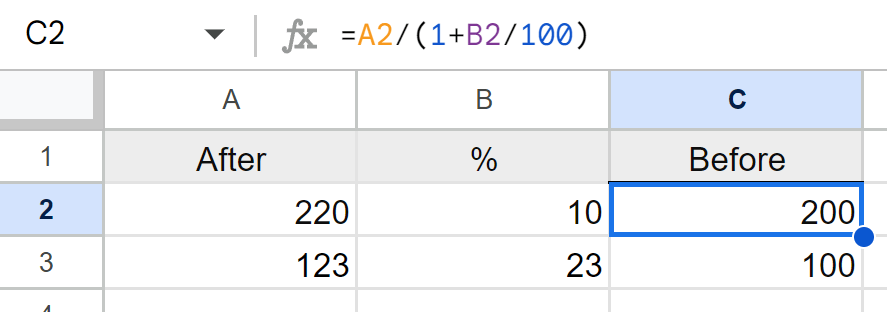Quickly find the number before a percentage increase using our accurate and easy-to-use online calculator. Ideal for financial analysis, math assignments, or everyday calculations, this tool takes the guesswork out of percentages. Save time and effort by letting our efficient calculator handle the details for you.
To find the original number before a percentage increase, you can reverse the calculation. Here's a step-by-step guide on how to do it.
Percentage increase tells you how much the original number has been increased by a certain percentage. For example, if a number increases by 20%, you know that the final number is 120% of the original.
You need two numbers: the final number (after the increase) and the percentage of increase. For example:
Add the percentage increase to 100 to get the percentage of the original number. Then convert that percentage into a decimal. For example:
Percentage after increase = 100% + 20% = 120%
As a decimal: 120% = 1.20
To find the original number, divide the final number by the decimal from Step 3:
Original Number = Final Number / Decimal
For this example: Original Number = 120 / 1.20 = 100
You can verify the calculation by checking if the original number plus the percentage increase gives you the final number:
Original Number + (20% of Original Number) = Final Number
100 + (20% of 100) = 120
Formula is =A2/(1+B2/100), where A2 is the "After" number, and B2 is the "Percentage".

If you know the final number after a percentage increase and want to find the original value, Windows Calculator can help. For this example, let’s say the final value is 130 after a 30% increase.
Press , type , and press .
Type (the value after the increase).
If something was increased by 30%, the final value is 130% of the original.
After pressing , the Calculator will display , which is the original number before the 30% increase.
Scenario: A product costs $120 after a 20% markup. What was the original price?
Calculation: Find the original price before a 20% increase.
Let X be the original price. The final price is 120% of the original price.
$120 = X × (1 + 0.20)
$120 = X × 1.20
X = $120 / 1.20 = $100
Result: The original price before the 20% markup was $100.
Scenario: Your salary is now $55,000 after a 10% increase. What was your salary before the increase?
Calculation: Find the salary before a 10% increase.
Let X be the original salary. The current salary is 110% of the original salary.
$55,000 = X × (1 + 0.10)
$55,000 = X × 1.10
X = $55,000 / 1.10 = $50,000
Result: The salary before the 10% increase was $50,000.
Scenario: A meal costs $138 after including an 8% tax. What was the cost before tax?
Calculation: Find the cost before an 8% increase.
Let X be the cost before tax. The final cost is 108% of the pre-tax cost.
$138 = X × (1 + 0.08)
$138 = X × 1.08
X = $138 / 1.08 = $127.78
Result: The cost before tax was approximately $127.78.
Scenario: A tuition fee of $1,200 is the result after a 15% increase. What was the original fee?
Calculation: Find the original fee before a 15% increase.
Let X be the original fee. The final fee is 115% of the original fee.
$1,200 = X × (1 + 0.15)
$1,200 = X × 1.15
X = $1,200 / 1.15 = $1,043.48
Result: The original tuition fee was approximately $1,043.48.
Scenario: An asset is worth $900 after a 25% appreciation. What was its original value?
Calculation: Find the value before a 25% increase.
Let X be the original value. The appreciated value is 125% of the original value.
$900 = X × (1 + 0.25)
$900 = X × 1.25
X = $900 / 1.25 = $720
Result: The value before the 25% appreciation was $720.
| Final Value | Percent Increase (%) | Original Number |
|---|---|---|
| 130 | 30 | 100 |
| 115 | 15 | 100 |
| 110 | 10 | 100 |
| 210 | 20 | 175 |
| 266.67 | 25 | 213.33 |
| 150 | 50 | 100 |
| 155 | 55 | 100 |
| 170 | 70 | 100 |
| 146.67 | 10 | 133.33 |
| 420 | 40 | 300 |
| 300 | 20 | 250 |
| 125 | 25 | 100 |
| 140 | 40 | 100 |
| 134.44 | 10 | 122.22 |
| 105 | 5 | 100 |
| 220 | 10 | 200 |
| 165 | 10 | 150 |
| 145 | 45 | 100 |
| 152 | 52 | 100 |
| 150 | 25 | 120 |